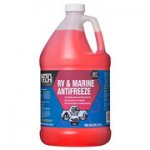Current Pool School recommendations for Closing an in ground pool says the following:
However, as I note starting with this post, propylene glycol and chlorine may react with each other. This may not only create a huge chlorine demand though one that is seen as slow over an extended period of time (so a few ppm FC of extra demand for many months), but may also create chloroform which is an EPA-regulated chlorine disinfection by-product as part of trihalomethanes (THMs).
While it makes sense to blow out lines and cap them, the use of antifreeze may be questionable unless that antifreeze is removed from the line rather than dumped into the pool water upon opening.
The issue is not the propylene glycol itself which is non-toxic, but rather 1) whether chlorine reacts with it creating a slow-burn extra chlorine demand and 2) whether the by-products of such chlorine reaction include chemicals that are toxic at higher concentrations such as chloroform. It should be noted that "swimming pool anti-freeze" which is propylene glycol is sold on the market so it would be a bit surprising if it did react with chlorine especially if it were to produce chloroform. Perhaps for most people the reaction is so slow as to not have a noticeably higher chlorine demand and perhaps the reaction by-products are mostly chemicals other than chloroform.
Anti-freeze - I add pool/RV anti-freeze (not automotive!) to the pipes at the rate of one gallon per ten feet or fifteen feet of pipe. It is a great help to have a curved funnel to get the anti-freeze into the return line.
However, as I note starting with this post, propylene glycol and chlorine may react with each other. This may not only create a huge chlorine demand though one that is seen as slow over an extended period of time (so a few ppm FC of extra demand for many months), but may also create chloroform which is an EPA-regulated chlorine disinfection by-product as part of trihalomethanes (THMs).
While it makes sense to blow out lines and cap them, the use of antifreeze may be questionable unless that antifreeze is removed from the line rather than dumped into the pool water upon opening.
The issue is not the propylene glycol itself which is non-toxic, but rather 1) whether chlorine reacts with it creating a slow-burn extra chlorine demand and 2) whether the by-products of such chlorine reaction include chemicals that are toxic at higher concentrations such as chloroform. It should be noted that "swimming pool anti-freeze" which is propylene glycol is sold on the market so it would be a bit surprising if it did react with chlorine especially if it were to produce chloroform. Perhaps for most people the reaction is so slow as to not have a noticeably higher chlorine demand and perhaps the reaction by-products are mostly chemicals other than chloroform.


